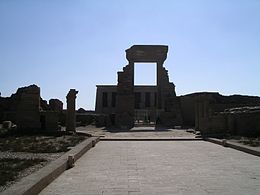- Merkhet
-
The merkhet ("instrument of knowing") was an ancient timekeeping instrument. It involved the use of a bar with a plumb line, attached to a wooden handle.[1] It was used to track the alignment of certain stars, if they were visible, in order to approximate the time at night (10 stars for the 10 hours of the night, with a total of 24 hours including 12 hours for the day, 1 hour for sunset, 1 hour for sunrise). In this way, it was more efficient than other contemporary devices, such as sundials, which were rendered useless during the dark.[2]
Contents
Design
The exact design of the merkhet consists of a horizontal bar, usually carved from wood or bone, with a plumb line hanging from a transverse hole at one raised end of the bar, attached to a controlling wooden handle. As deduced by texts and engravings on the inner walls of the temples of Dendera and Edfu, the merkhet was typically used in conjunction with a corresponding sighting tool, which the Egyptians called a bay, itself made from a specially cut palm-rib with a sliced "V" shape at one end. The two together could also be used, as appropriate, to determine North.[3]
For the operation to work, two merkhets were required, one aligned with Polaris, the North Pole star. If erected properly, and if a bay was on hand, one could estimate quite accurately the time by observing the transits of certain stars as they crossed the meridian and came into alignment with the two merkhets.[1]
Preservations
A few merkhets have been excavated and preserved, including one that is on exhibition in the Science Museum in London. This particular exhibit dates to 600 BC, and, according to a related inscription, belonged to the son of a priest who hailed from a temple dedicated to the Egyptian god Horus, located close to Edfu in Upper Egypt.[1]
See also
- History of timekeeping
- History of timekeeping devices in Egypt
Notes
References
- Grimal, Nicolas; Ian Shaw (1992). A History of Ancient Egypt. Blackwell Publishing. ISBN 0631193960.
- Whitrow, G. J. (1989). Time in History: Views of Time from Prehistory to the Present Day. Oxford University Press. ISBN 0192852116.
- Stocks, Denys A. (2003). Experiments in Egyptian Archaeology: Stoneworking Technology in Ancient Egypt. Routledge. ISBN 0415306647.
Categories:- Ancient Egyptian culture
- Timekeeping
Wikimedia Foundation. 2010.

